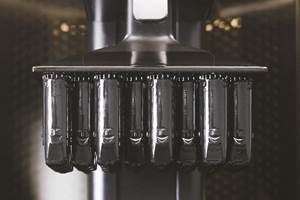APSX and Nexa3D Integrate Technologies to Advance Freeform Injection Molding
With the combined APSX-PIM and Nexa3D technologies, users can seamlessly transition from 3D printing prototypes to injection-molded production parts, all within a single, integrated ecosystem.
Share
Read Next
The Freeform Injection Molding (FIM) package includes everything users need to start printing tools and then produce parts right on the desktop, in which a rapidly evolving product development process, simplicity, speed and cost-effectiveness are paramount. Source: APSX
In a recent collaboration, APSX and Nexa3D say their united technologies can pioneer a new era in manufacturing. Their partnership engineers a seamless integration of the APSX-PIM desktop injection molding machine with Nexa3D’s 3D printers, culminating in a solution for freeform injection molding (FIM).
The companies say this synergy between precision injection molding and rapid 3D printing opens doors to unprecedented possibilities in product design, prototyping and production. It is said the FIM represents a paradigm shift in product development, enabling the creation of complex geometries and intricate designs that were previously unattainable through traditional manufacturing methods.
The APSX-PIM, known for its compact footprint and user-friendly interface, empowers businesses of all sizes to engage in injection molding with ease. Now, with the integration of Nexa3D’s advanced 3D printing capabilities, the APSX-PIM can transcend conventional boundaries, offering a comprehensive desktop FIM package that can transform manufacturing workflows.
By harnessing the precision and speed of Nexa3D’s printers, coupled with the versatility of the APSX-PIM, manufacturers can accelerate their innovation cycles and bring concepts to reality within a day. With the APSX-PIM and Nexa3D collaboration, users can seamlessly transition from 3D printing prototypes to injection molded production parts, all within a single, integrated ecosystem. This streamlined approach eliminates the need for costly and time-consuming tooling processes, thereby reducing lead times and maximizing productivity.
The benefits of FIM extend beyond prototyping, offering tangible advantages in various industries, including automotive, aerospace, consumer goods and more. Whether it’s rapid iteration during the design phase or on-demand production of end-use parts, the APSX-PIM and Nexa3D partnership empowers businesses to stay ahead in today's competitive market landscape. The basic steps for fully utilizing the integrated technologies follows.
Step-by-Step Guide: Making Parts with Nexa3D XiP and APSX-PIM
- Design: Begin the process by creating a 3D model of the desired part using CAD software. Leverage the freedom of design afforded by FIM to explore intricate geometries and complex structures.
- 3D Printing With Nexa3D XiP: Once the design is finalized, users transfer the model to the Nexa3D XiP printer, which will swiftly transforms digital designs into high-resolution 3D printed prototypes with speed and accuracy.
- Validation and Iteration: Evaluate the printed prototype to ensure it meets design specifications. With the rapid turnaround time of Nexa3D’s printers, users can iterate quickly to refine the design and address any potential issues.
- Mold Creation: Once the prototype is approved, users can proceed to create the mold using the Nexa3D mold generator software or another CAD software. Then 3D print the mold by using the xMOLD material on the Nexa3D XiP printer.
- Injection Molding: With the mold in place, users initiate the injection molding process using the APSX-PIM. The machine’s precise control and repeatability ensure consistent results, delivering high-quality parts with each cycle.
- Final Inspection: Conduct a thorough inspection of the molded parts to verify dimensional accuracy and test part functionality. Fine-tune the design until it hits your targets. With FIM, users can achieve tight tolerances and superior surface finishes to meet the most demanding specifications.
- Production Scaling: With the optimized workflow enabled by the APSX-PIM and Nexa3D collaboration, users can seamlessly scale production to meet demand while maintaining the highest standards of quality and efficiency.
To showcase the transformative potential of FIM, APSX has released a helpful blog post on its website as well as a video on its YouTube channel which delves into the capabilities and applications of this technology.
Related Content
AM 101: Digital Light Synthesis (DLS)
Digital Light Synthesis (DLS) is the name for Carbon's resin-based 3D printing process. How it works and how it differs from stereolithography.
Read MoreThis Drone Bird with 3D Printed Parts Mimics a Peregrine Falcon: The Cool Parts Show #66
The Drone Bird Company has developed aircraft that mimic birds of prey to scare off problem birds. The drones feature 3D printed fuselages made by Parts on Demand from ALM materials.
Read MoreWhat is Powder Bed Fusion 3D Printing?
Whether in metal or polymer, with a laser or an electron beam, powder bed fusion (PBF) is one of the most widely used 3D printing techniques.
Read MoreActivArmor Casts and Splints Are Shifting to Point-of-Care 3D Printing
ActivArmor offers individualized, 3D printed casts and splints for various diagnoses. The company is in the process of shifting to point-of-care printing and aims to promote positive healing outcomes and improved hygienics with customized support devices.
Read MoreRead Next
Hybrid Additive Manufacturing Machine Tools Continue to Make Gains (Includes Video)
The hybrid machine tool is an idea that continues to advance. Two important developments of recent years expand the possibilities for this platform.
Read MoreAt General Atomics, Do Unmanned Aerial Systems Reveal the Future of Aircraft Manufacturing?
The maker of the Predator and SkyGuardian remote aircraft can implement additive manufacturing more rapidly and widely than the makers of other types of planes. The role of 3D printing in current and future UAS components hints at how far AM can go to save cost and time in aircraft production and design.
Read More3D Printing Brings Sustainability, Accessibility to Glass Manufacturing
Australian startup Maple Glass Printing has developed a process for extruding glass into artwork, lab implements and architectural elements. Along the way, the company has also found more efficient ways of recycling this material.
Read More























